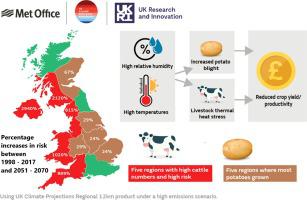Climate Risk Management ( IF 4.8 ) Pub Date : 2021-02-01 , DOI: 10.1016/j.crm.2021.100282 Freya K. Garry , Dan J. Bernie , Jemma C.S. Davie , Edward C.D. Pope

|
Assessments of current and future climate risk are required for adaptation planning to increase resilience and enable society to cope with future climate hazards. Here we identify case studies of compound hazard events of interest to the UK agricultural sector and present a framework for comparing the frequency and duration of compound events now to those projected in 50 years’ time. We use high resolution (12 km) simulations from the UK Climate Projections to explore how the frequency and duration of instances of potato blight and thermal heat stress to dairy cattle may change locally under RCP 8.5 emissions forcing. We combine hazard (temperature and humidity data) with vulnerability (specific threshold exceedance) and exposure (regional dairy cattle numbers/potato growing area) to estimate risk. Regions where most potatoes are grown, and where the potato blight risk is greatest in both the current and future climate, include the East of England, Yorkshire and the Humber and Eastern Scotland. By 2070, potato blight occurrences may increase by 70% in East Scotland and between 20 and 30 % across the East of England, the Midlands and Yorkshire and the Humber. Assuming dairy cattle spatial distributions remain the same, the area of greatest risk now and in the future is South West England, with notable increases in risk across Northern Ireland, Wales, the Midlands, North West England and North West Scotland. Dairy cattle heat stress (using a temperature-humidity index) is projected to increase by nearly 1000% in South West England, the region with the most dairy cattle. Finally, we consider projected changes to UK seasons, using 2018 as a template, where a cold spring followed by a warm/dry summer resulted in hay/silage shortages. In addition to reduced crop yields in 2018, cattle were kept inside for longer in the cold spring and in the warm/dry summer, due to heat stress and poor grass quality. UK Climate Projections indicate that the annual probability of cold spring/warm summer conditions will decrease in future, but the annual probability of longer dry/warm summers will increase. We conclude that the agricultural sector should consider suitable climate adaptation measures to minimise the risk of dairy cattle thermal heat stress, increased potato blight, and longer dry/warm summer conditions.
中文翻译:

复合事件对英国农业的未来气候风险
需要进行当前和将来的气候风险评估,以进行适应规划,以增强适应力,并使社会能够应对未来的气候危害。在这里,我们确定了英国农业部门感兴趣的复合危害事件的案例研究,并提出了一个框架,用于将现在的复合事件的频率和持续时间与50年后的预测相比较。我们使用来自英国气候预测的高分辨率(12 km)模拟,以探索在RCP 8.5排放强迫下,马铃薯枯萎病和奶牛热应激的发生频率和持续时间如何在本地发生变化。我们将危害(温度和湿度数据)与脆弱性(超过特定阈值)和暴露(区域奶牛数量/马铃薯种植面积)相结合,以评估风险。马铃薯种植最多的地区 在当前和将来的气候中,马铃薯疫病风险最大的地区包括英格兰东部,约克郡,亨伯和苏格兰东部。到2070年,马铃薯疫病的发生率在苏格兰东部地区可能会增加70%,在英格兰东部,中部地区,约克郡和亨伯地区则可能会增加20%至30%。假设奶牛的空间分布保持不变,则当前和将来风险最大的地区是英格兰西南部,北爱尔兰,威尔士,中部地区,英格兰西北部和苏格兰西北部的风险显着增加。预计在英格兰西南部奶牛最多的地区,奶牛的热应激(使用温度-湿度指数)将增加近1000%。最后,我们以2018年为模板,考虑英国季节的预计变化,春季寒冷,夏季温暖/干燥,导致干草/青贮饲料短缺。除了2018年农作物减产外,由于热胁迫和劣质草,在寒冷的春季和温暖/干燥的夏季,牲畜的饲养时间更长。英国气候预测指出,未来寒冷春季/夏季温暖的年度可能性将降低,但是较长的干燥/温暖夏季的年度可能性将增加。我们得出的结论是,农业部门应考虑采取适当的气候适应措施,以最大程度地降低奶牛热应激,马铃薯白叶枯病增加和夏季干燥/温暖的条件的风险。由于热应激和较差的草质。英国气候预测指出,未来寒冷春季/夏季温暖的年度可能性将降低,但是较长的干燥/温暖夏季的年度可能性将增加。我们得出的结论是,农业部门应考虑采取适当的气候适应措施,以最大程度地降低奶牛热应激,马铃薯白叶枯病增加和夏季干燥/温暖的条件的风险。由于热应激和较差的草质。英国气候预测指出,未来寒冷春季/夏季温暖的年度可能性将降低,但是较长的干燥/温暖夏季的年度可能性将增加。我们得出的结论是,农业部门应考虑采取适当的气候适应措施,以最大程度地降低奶牛热应激,马铃薯白叶枯病增加和夏季干燥/温暖的条件的风险。











































 京公网安备 11010802027423号
京公网安备 11010802027423号